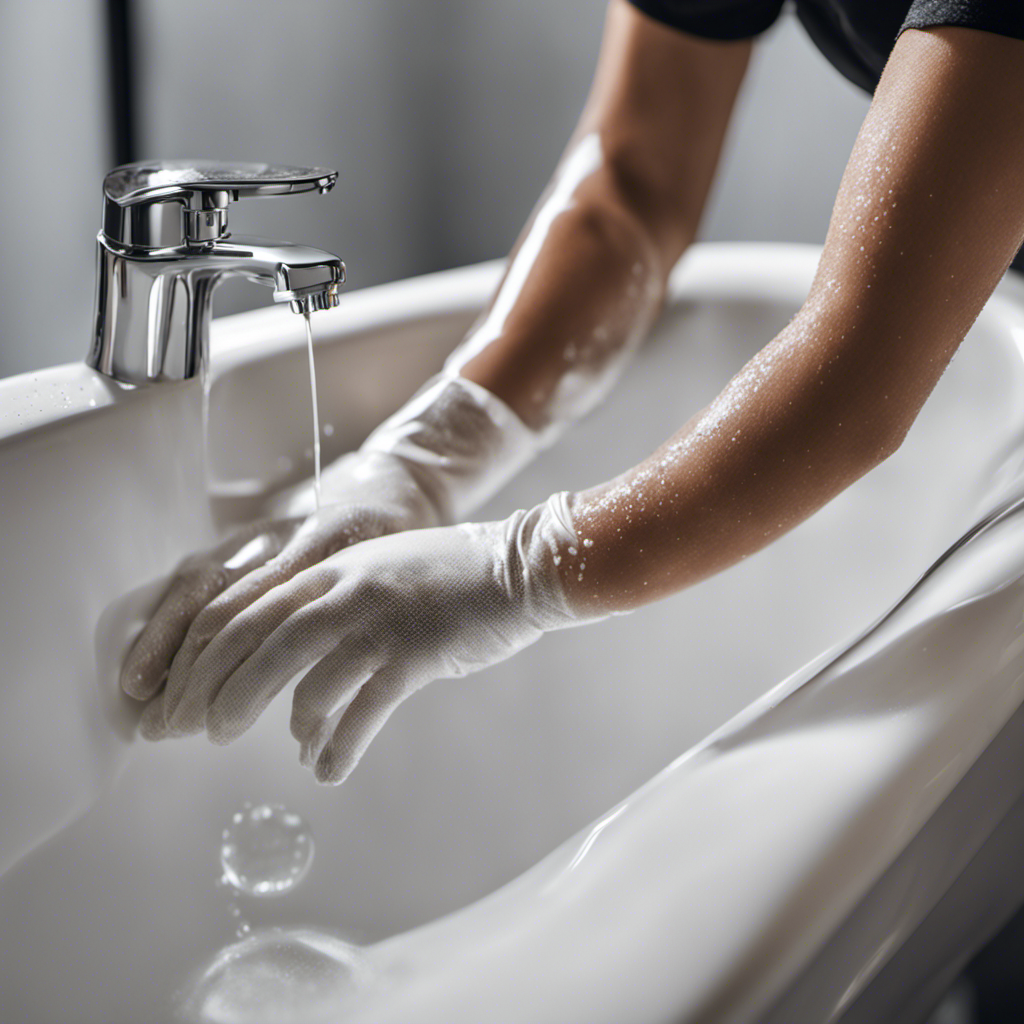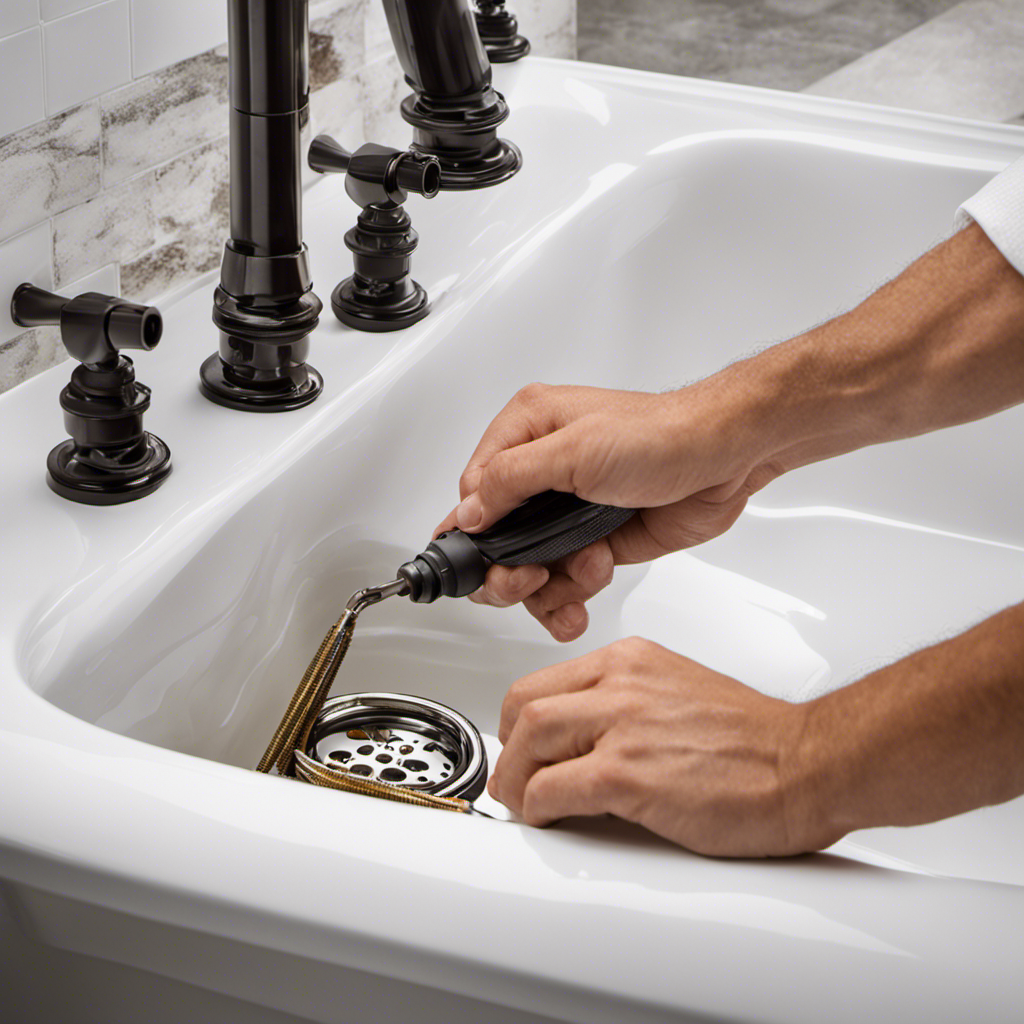Looking to keep your bathtub clean and germ-free? Look no further! In this article, we’ll show you how to disinfect your bathtub effectively. Say goodbye to grime and hello to a sparkling clean tub.
By following our step-by-step guide and using simple supplies, you’ll have your bathtub squeaky clean in no time. Whether you prefer chemical disinfectants or natural alternatives, we’ve got you covered.
Get ready to transform your bathtub into a pristine oasis!
Key Takeaways
- Regular disinfection is important to remove dirt, grime, and harmful microorganisms from the bathtub.
- Natural disinfectants like vinegar and baking soda are eco-friendly and effective against germs and soap scum.
- Chemical disinfectants such as bleach and hydrogen peroxide can be highly effective in killing germs.
- It is crucial to follow instructions and safety precautions when using any disinfectants.
Understanding the Importance of Bathtub Disinfection
Understanding the importance of bathtub disinfection is crucial for ensuring a clean and hygienic bathing experience. Regular disinfection of your bathtub is essential to remove dirt, grime, bacteria, and other harmful microorganisms that can accumulate over time.
By regularly disinfecting your bathtub, you can prevent the growth of mold and mildew, which can cause health problems and damage to your bathroom. Using natural disinfectants such as vinegar, hydrogen peroxide, or baking soda not only ensures a thorough cleaning but also offers additional benefits. These natural disinfectants are eco-friendly, cost-effective, and safe for you and your family.
Transitioning into the next section, gathering the necessary supplies for disinfecting your bathtub is the next step towards achieving a clean and sanitized bathing space.
Gathering the Necessary Supplies for Disinfecting Your Bathtub
To gather the necessary supplies for disinfecting your bathtub, you’ll need some cleaning solution and a scrub brush. Here are a few other items you may find helpful:
- Rubber gloves: Protect your hands from harsh chemicals and bacteria.
- Microfiber cloth: Ideal for wiping down surfaces and removing dirt and grime.
- Spray bottle: Fill it with your chosen disinfectant for easy application.
- Toothbrush: Useful for reaching small crevices and corners.
- Vinegar: An all-natural disinfectant that is effective against germs and soap scum.
When choosing the right disinfectant, consider the type of material your bathtub is made of. For porcelain or acrylic tubs, a mild bleach solution or hydrogen peroxide can be used. For natural stone or marble tubs, opt for a pH-neutral cleaner to avoid damage.
Always follow the instructions on the cleaning solution and allow it to sit for the recommended time before scrubbing and rinsing thoroughly.
Preparing the Bathtub for the Disinfection Process
To effectively prepare your bathtub for the disinfection process, there are a few key points to consider.
First, gather the necessary cleaning products required, such as a disinfectant spray or wipes, a scrub brush, and gloves.
Second, ensure you take the necessary safety precautions by wearing protective gear, such as goggles and a mask, to prevent any potential harm from the cleaning chemicals.
Cleaning Products Required
You’ll need some cleaning products to disinfect your bathtub. Here are some options to consider for effective and eco-friendly cleaning techniques:
-
Vinegar: Mix equal parts of white vinegar and water to create a natural cleaning solution. Vinegar is known for its disinfecting properties and can remove soap scum and stains effectively.
-
Baking Soda: This versatile product can be used to scrub away grime and odors. Sprinkle baking soda on a damp sponge and scrub your bathtub’s surface.
-
Lemon Juice: The acidic properties of lemon juice can help remove tough stains and leave your bathtub smelling fresh. Mix lemon juice with water and apply it to the stains before scrubbing.
-
Hydrogen Peroxide: This natural disinfectant can effectively kill bacteria and mold. Apply hydrogen peroxide directly to the surface and let it sit for a few minutes before rinsing.
-
Castile Soap: This eco-friendly soap is made from vegetable oils and is gentle yet effective at removing dirt and grime.
With these cleaning products, you can disinfect your bathtub using eco-friendly options that are both safe and effective.
Safety Precautions Necessary
Be cautious and take necessary safety precautions when using these cleaning products in your bathroom. Whether you choose chemical or natural disinfectants, it is important to understand the potential risks of improper disinfection techniques.
Chemical disinfectants, while effective at killing germs, can be harmful if not used correctly. Always read and follow the instructions on the label, wear protective gloves, and ensure proper ventilation.
Natural disinfectants, like vinegar and hydrogen peroxide, are safer alternatives, but they may not be as potent against certain germs. Regardless of the type of disinfectant you choose, always test it on a small, inconspicuous area of your bathtub first to check for any adverse reactions.
Taking these safety precautions will help protect you and your family while ensuring effective disinfection of your bathroom.
Effective Disinfection Techniques
Now that you know the safety precautions necessary for disinfecting your bathtub, let’s talk about some effective techniques and alternative methods you can use. Here are five options for you to consider:
-
Bleach Solution: Mix 1/3 cup of bleach with 1 gallon of water and scrub the bathtub with this solution. Let it sit for a few minutes before rinsing.
-
Vinegar and Baking Soda: Create a paste by mixing equal parts vinegar and baking soda. Apply it to the tub’s surface and scrub with a sponge or brush.
-
Hydrogen Peroxide: Fill a spray bottle with hydrogen peroxide and spray it all over the bathtub. Let it sit for a while before rinsing.
-
Steam Cleaner: Use a steam cleaner specifically designed for cleaning bathrooms. The high heat will kill bacteria and sanitize the tub.
-
Commercial Disinfectant: Purchase a commercial disinfectant from the store and follow the instructions on the label to effectively disinfect your bathtub.
Try these alternative methods and choose the one that works best for you and your bathtub.
Using Chemical Disinfectants to Clean and Sanitize the Bathtub
When it comes to cleaning and sanitizing your bathtub, it’s important to choose the best disinfectant options and use proper application techniques.
There are various disinfectants available, such as bleach, hydrogen peroxide, and alcohol-based solutions, each with their own advantages and considerations.
Understanding the proper way to apply these disinfectants will ensure effective and thorough cleaning, helping to eliminate germs and maintain a hygienic bathtub environment.
Best Disinfectant Options
To find the best disinfectant options for your bathtub, you should consider using bleach or hydrogen peroxide. These two options are highly effective in killing germs and bacteria.
Here are some other disinfectants that you can try:
-
Vinegar: It is a natural disinfectant that can help remove soap scum and stains.
-
Baking soda: This versatile ingredient not only cleans but also deodorizes your bathtub.
-
Tea tree oil: Known for its antimicrobial properties, it can be mixed with water to create a homemade disinfectant spray.
-
Lemon juice: Its acidic nature makes it a great disinfectant and also helps remove tough stains.
-
Eucalyptus oil: It has a refreshing scent and can be mixed with water to create a disinfectant solution.
Remember to always follow the instructions and safety precautions when using any disinfectant.
Proper Application Techniques
Using the recommended disinfectants correctly is crucial for effectively killing germs and bacteria in your bathtub. To ensure proper application techniques, start by reading the instructions on the disinfectant label.
Dilute the disinfectant as directed, and wear gloves to protect your hands. Before applying the disinfectant, thoroughly clean the bathtub with a mild detergent to remove any dirt or grime.
Then, spray or wipe the disinfectant onto the surfaces of the bathtub, paying special attention to high-touch areas like the faucet and handles. Allow the disinfectant to sit for the recommended amount of time, usually around 5 to 10 minutes, to ensure maximum effectiveness.
Exploring Natural Alternatives for Disinfecting Your Bathtub
You can try using vinegar and baking soda as natural alternatives to disinfect your bathtub. These homemade cleaners are effective in killing bacteria and removing stains without the use of harsh chemicals. Here are some reasons why you should give them a try:
- Vinegar is a powerful natural disinfectant that can kill germs and bacteria on contact.
- Baking soda acts as a gentle abrasive, helping to remove tough stains and grime.
- Both vinegar and baking soda are non-toxic and safe to use around children and pets.
- They are readily available and inexpensive, making them budget-friendly options.
- Using natural disinfectants promotes a healthier environment and reduces your exposure to harmful chemicals.
Now that you know the benefits of using vinegar and baking soda, let’s move on to the next step: applying the disinfectant solution to the bathtub surfaces.
Applying the Disinfectant Solution to the Bathtub Surfaces
Now that you have explored natural alternatives for disinfecting your bathtub, it’s time to move on to applying the disinfectant solution to the bathtub surfaces.
First, prepare the solution by following the instructions provided on the disinfectant product. This may involve diluting the solution with water or using it as is. Once the solution is ready, pour it into a spray bottle for easy application.
Start by spraying the solution evenly onto the bathtub surfaces, ensuring that all areas are covered. Use a clean cloth or sponge to spread the solution, making sure to reach the corners and edges.
Allow the disinfectant to sit for the recommended time before rinsing thoroughly with water. By applying the solution evenly, you can effectively disinfect your bathtub and maintain a clean and hygienic environment.
Scrubbing and Removing Stains During the Disinfection Process
To effectively remove stains during the disinfection process, start scrubbing the surfaces gently with a sponge or brush. This will ensure that bacteria and germs are eliminated while leaving your bathtub sparkling clean. Here are some tips to help you tackle those tough stains and prevent bacterial growth:
- Use a cleaning solution specifically designed for removing stains and killing bacteria.
- Apply the solution to the stained areas and let it sit for a few minutes to loosen the dirt.
- Scrub the stains gently using a sponge or brush, focusing on the affected areas.
- Rinse the surfaces thoroughly with water to remove any residue.
- Dry the bathtub with a clean towel to prevent moisture buildup and further bacterial growth.
Rinsing and Drying the Bathtub After Disinfection
After applying the cleaning solution and scrubbing the stained areas, it is important to thoroughly rinse and dry the bathtub to prevent moisture buildup and bacterial growth.
To ensure a proper rinse, start by using a detachable showerhead or a bucket of clean water to rinse off the cleaning solution and any remaining dirt or grime. Pay attention to hard-to-reach areas like corners and crevices.
Next, use a clean cloth or towel to dry the bathtub completely. Make sure to reach all surfaces, including the sides and bottom. If you want to speed up the drying process, open a window or turn on a fan to promote air circulation.
Maintaining a Regular Bathtub Disinfection Routine to Prevent Future Contamination
Regularly cleaning and drying your tub helps prevent the spread of germs and maintains a clean environment. To maintain hygiene and prevent bacterial growth, follow these simple steps:
- After each use, rinse the bathtub with warm water to remove any dirt or soap residue.
- Use a mild cleaning agent or a mixture of vinegar and water to scrub the tub’s surface thoroughly.
- Pay special attention to the corners, edges, and any hard-to-reach areas where bacteria can thrive.
- Rinse the tub again with warm water to remove any cleaning solution residue.
- Finally, dry the tub completely with a clean towel or allow it to air dry to prevent moisture buildup.
Frequently Asked Questions
Can I Use Bleach to Disinfect My Bathtub?
You can use bleach to disinfect your bathtub, but there are also bleach alternatives that work well. To ensure the best cleaning techniques, follow instructions on the product and ventilate the area.
How Often Should I Disinfect My Bathtub?
To maintain cleanliness and prevent the buildup of bacteria, it is recommended that you disinfect your bathtub at least once a week. Follow best practices, such as using a bleach solution, to ensure effective disinfection.
Is It Necessary to Wear Gloves When Using Chemical Disinfectants?
Wearing gloves when using chemical disinfectants is crucial for safety. A case study found that a person experienced skin irritation after not wearing gloves. Protect yourself by always wearing gloves to prevent any potential harm.
Can I Use Vinegar as a Natural Alternative to Disinfect My Bathtub?
Yes, you can use vinegar as a natural alternative to disinfect your bathtub. However, using hydrogen peroxide as a bathtub disinfectant has more benefits. It is effective and kills a wider range of germs.
Are There Any Specific Cleaning Products I Should Avoid Using on My Bathtub?
When disinfecting your bathtub, avoid using harsh chemicals like bleach or ammonia, as they can damage the surface. Instead, opt for vinegar or hydrogen peroxide, which are effective natural alternatives.
Conclusion
In conclusion, keep in mind that a clean bathtub is like a sanctuary for relaxation and rejuvenation. By regularly disinfecting your bathtub, you not only eliminate harmful bacteria and germs but also create a safe and hygienic environment for yourself and your loved ones.
So, grab your supplies, don’t forget those gloves, and embark on your cleaning journey. Remember, a disinfected bathtub is a sparkling oasis where you can wash away your worries and emerge refreshed.
Happy cleaning!










